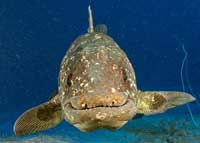 Coelacanths apparently evolved in their current form around 400 million years ago. They were thought to have gone extinct 65 million years ago, during the Cretaceous-Tertiary extinction – that is, until 1938 when a fisherman in South Africa pulled one up in his nets. Not surprisingly, they are often referred to as “living fossils.” Since their discovery off South Africa, they have also been found in the waters off the Comoros, Kenya, Tanzania, Mozambique, Madagascar. In 1999, coelacanths were also found in the waters of Indonesia off Sulawesi.
Coelacanths apparently evolved in their current form around 400 million years ago. They were thought to have gone extinct 65 million years ago, during the Cretaceous-Tertiary extinction – that is, until 1938 when a fisherman in South Africa pulled one up in his nets. Not surprisingly, they are often referred to as “living fossils.” Since their discovery off South Africa, they have also been found in the waters off the Comoros, Kenya, Tanzania, Mozambique, Madagascar. In 1999, coelacanths were also found in the waters of Indonesia off Sulawesi.
Now German scientists have found something else quite remarkable about these rare fish. After a twenty year study they have determined that coelacanths can live up to a hundred years and possibly even longer. This would make the coelacanth not only one of the world’s oldest fish species, but possibly also the longest-lived. Thanks to coelacanth savant and prodigious polymath, Allan Janus for pointing out the article.

Interesting creatures, did not know of their existence , thanks for passing on !
The info here is rather generalized. The creature illustrated is genus Latimeria, the only living member of the very large group “Coelacanths”, meaning “hollow spined” fish.
Latimeria has been analyzed as being a 40-million year old specie, rather recently appearing. There are no known fossils of Latimeria, and no fossils of any “hollow-spined” fish after 70 million years ago.
The group http://en.wikipedia.org/wiki/Coelacanthidae went extinct more than 145 million years ago. Applying the name to the modern Latimeria is a convenience but an inaccurate one.
The chart at http://en.wikipedia.org/wiki/Coelacanth#Timeline_of_genera shows that “Coelacanths” are a quite varied group. There are several gaps in the fossil record, most likely because the environs of these fish are not currently near the modern ground level